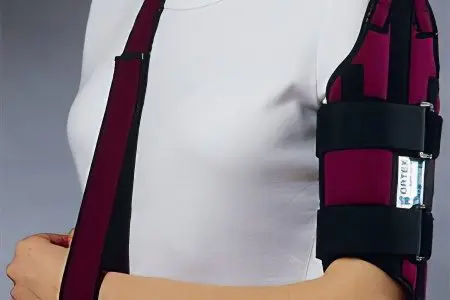Contents
A fracture of the surgical neck of the shoulder occurs due to a fall or any other physical impact on this area. Most often, such injuries occur in the female half of the population, who are in old age. In this category of patients, various diseases of the musculoskeletal system develop over time, against which the bones become more fragile. They are damaged both due to a slight physical impact on the area of the shoulder girdle, and when the upper limbs are in the wrong position for a long time.
Such fractures can be of the following types:
hammered;
adduction, occur when a person falls on a bent upper limb;
abduction, occur when falling on a limb laid aside.
Displaced shoulder fracture

In case of a fracture of the surgical neck of the shoulder, the specialist can feel the displaced bone fragments by palpation. In some cases, they can be seen visually, as they protrude from under the skin. In such patients, a hematoma and severe edema appear almost instantly in the area of damage. The strongest pain causes excruciating suffering in the victims, therefore, upon admission to a medical institution, they are immediately anesthetized. If a fracture of the humerus with displacement is suspected, x-rays in several projections are required, thanks to which the specialist will be able to determine the real picture of the problem and choose the correct treatment technique. Sometimes there are cases in which, during a fracture of the surgical neck of the shoulder, bone fragments begin to put pressure on the neurovascular bundle.
This often ends in severe complications:
paresthesia;
severe swelling of the upper limb;
paralysis;
necrosis of the injured limb;
the appearance of an aneurysm, etc.
Shoulder fracture without displacement
To date, a fracture of the surgical neck of the shoulder is not so common, in 7% of all cases of damage to the bones of the musculoskeletal system.
Patients may present with a fracture in any part of the humerus:
in the distal;
in the middle;
in the proximal.
During a fracture of the humerus without displacement of the fragments, hemorrhage occurs in the area of injury in patients. In all cases, without exception, edema appears, which greatly increases with time. In patients, the mobility of the injured upper limb is completely impaired, and with a slight movement they begin to experience severe pain. If the fracture is classified as impacted, then the patient will be able to perform passive hand movements. Against the background of such an injury, deformation of the shoulder joint can occur, so you should immediately contact a medical institution for qualified help.
Treatment of a fracture of the surgical neck of the shoulder

A patient who has a fracture of the surgical neck of the shoulder experiences severe pain, and also observes loss of mobility of the upper limb. These symptoms force him to go to a medical institution for qualified assistance. At the reception, the specialist will first of all conduct a personal examination of the patient, collect an anamnesis of the disease.
To obtain a more accurate clinical picture, the doctor will prescribe an additional examination to the patient, which includes a number of diagnostic measures. In most cases, this category of patients is immediately sent for x-rays, through which the type of fracture can be determined.
If the x-ray did not give the doctor a complete picture of the disease, the patient undergoes computed or magnetic resonance imaging, which can reveal damage to the muscle tissue in the area of the injured shoulder girdle.
If a fracture of the surgical neck of the shoulder is detected, patients can be treated on an outpatient basis. The specialist chooses the method of treatment individually, depending on the complexity of the fracture. With a normal fracture, the patient’s upper limb is fixed in a certain position, after which a plaster splint is applied to it and to the torso. This plaster bandage should be worn for 4-8 weeks, depending on the complexity of the fracture.
In the case when there is a displacement of bone fragments during a fracture, they are reduced to the patient in a hospital. This manipulation is accompanied by a strong pain syndrome, so patients are given local anesthesia. In very complex fractures, treatment is possible only surgically. During surgery, the patient is placed under general anesthesia, after which he undergoes an open reposition and fixation of bone fragments.
As a retainer, surgeons use special structures made of special medical alloys that do not undergo oxidation. Their main purpose is to bring together bone fragments (in which holes are pre-drilled) and securely fix them. With a well-performed operation, the patient can do without external immobilization. All metal fixators are dismantled from their bones 4 months after their installation.
Repeated surgical intervention is carried out only when the specialist is convinced that the fusion of bone fragments was successful. The functions of the injured shoulder and upper limb will be restored gradually, after the patient has completed a full course of rehabilitation.
Immobilization for a broken shoulder
In case of a fracture of the shoulder, patients need complete immobilization, for which a thoracobronchial dressing is used, for which specialists use traditional techniques:
The patient should be on a hill in a sitting position (you can use a high stool or table).
The injured upper limb must be placed in a specific position:
at an angle of 70-80 ° C – with fractures of the upper third of the humerus;
at an angle of 45 ° C – for fractures of the lower third of the humerus.
The injured shoulder must be flexed (the angle should not be in the range of 45 to 80 °C).
Around the patient’s torso (the area of the shoulder girdle, on the crests of the iliac bones, as well as the elbow, shoulder, wrist joints), cotton wool is laid out, which is fixed with a bandage or gauze.
On the sides of the trunk and the injured limb, plaster splints are applied, while the healthy shoulder is not fixed in any way and remains completely free and mobile.
To prevent damage to the corset, a special spacer is installed between it and the plastered upper limb, the functions of which can be performed by an ordinary wooden stick.
In case of complex (abduction) fractures, accompanied by displacement of bone fragments, after reduction, the Whitman-Gromov bandage is applied to patients. In the case when the fracture occurred in the lower third of the humerus, a plaster cast is applied to the injury site, which covers the upper limb of the patient in the form of a gutter.
Exercise therapy for shoulder fracture
In case of fractures of the surgical neck of the humerus, patients are prescribed a course of physiotherapy exercises. The patient will be able to perform special exercises already 2-3 days after receiving such an injury.
Such a course of exercise therapy is divided into several periods:
The first period physical therapy (lasts for 2 weeks) includes a set of exercises that patients must perform by tilting the torso towards the injured upper limb. All exercises are based on flexion and extension of the arms, performing various movements with them.
Second period physical therapy (on average, it lasts 4 weeks) includes exercises that involve torso, various movements of the upper limbs (swings, breeding, etc.), the use of sports equipment, etc. The third period of physical therapy lasts for 3 -4 weeks. During the implementation of a set of exercises, patients use various sports equipment and equipment: balls, dumbbells, maces, sticks, etc. Occupational therapy is very useful for this category of patients, during which they can do household chores, work in the garden, etc.
Third course Exercise therapy includes exercises during which patients do swings, flexion and extension of the arms, strength exercises. Patients are advised to visit the swimming pool, as water procedures have a positive effect on the musculoskeletal system as a whole and help the body recover from injuries. After completing each set of exercises, the patient should relax the muscles and do breathing exercises. Thanks to a specially designed set of exercises, patients who have suffered a fracture of the surgical neck of the humerus fully restore the range of motion, and they can lead an active lifestyle. Muscle tissues in the area of the injured limb come into tone and can fully function, as before.
Rehabilitation for a fracture of the neck of the shoulder

After constructive treatment of a fracture of the neck of the shoulder, patients need a fairly long rehabilitation. The program of rehabilitation measures begins with the restoration of the physical activity of patients. For them, a special set of exercises is being developed, separately for the upper and lower extremities.
Without fail, this category of patients is recommended to perform:
breathing exercises;
a set of exercises for the fingers;
develop joints;
movements of the upper limbs in different planes;
strain the muscles of the shoulder girdle, etc.
Patients can undergo rehabilitation both at home and in medical institutions, where there are rooms specially equipped for classes. Each exercise should be repeated 8-10 times, while you need to carefully “listen” to your own body and immediately stop training if pain occurs. A set of physical exercises must be performed daily. It is recommended to do 3-4 approaches, each of which lasts at least 15 minutes.
In addition to physical education, rehabilitation includes a set of physiotherapy procedures, which include:
magnetotherapy;
diadynamotherapy;
UHF;
massage;
phonophoresis;
salt baths;
mud therapy;
electrophoresis;
visiting the pool, etc.
Massage of this category of patients should be carried out by well-trained specialists who use modern techniques in their work, based on intermittent vibrations. For these purposes, the masseur uses either fingers or a wooden mallet, the purpose of which is to perform light taps on the patient’s plaster cast in the area of the fracture.
Over time, patients are encouraged to increase physical activity, especially in the area of the injured shoulder. Daily exercises, the time of which should be increased to 40 minutes, the patient should perform only after a thorough warm-up, during which all joints of the upper limbs and shoulder girdle are worked out and warmed up. After the first course of exercises, a set of breathing exercises should be performed, the purpose of which is to relax the muscles.
The final phase of rehabilitation includes a set of more complex exercises aimed at restoring the patient’s coordination, strength and dexterity. The daily physical education course includes throwing and catching the ball, passing it to a partner, etc. After undergoing rehabilitation, patients fully restore their professional and domestic activity.









